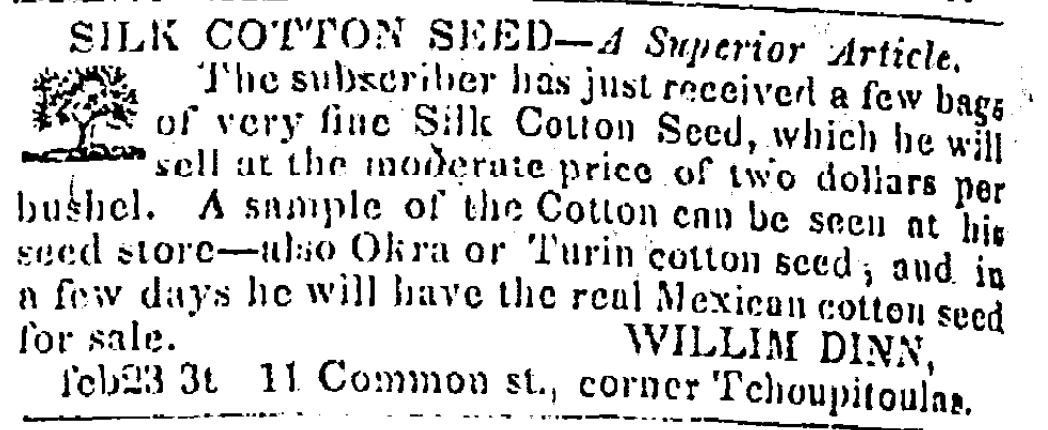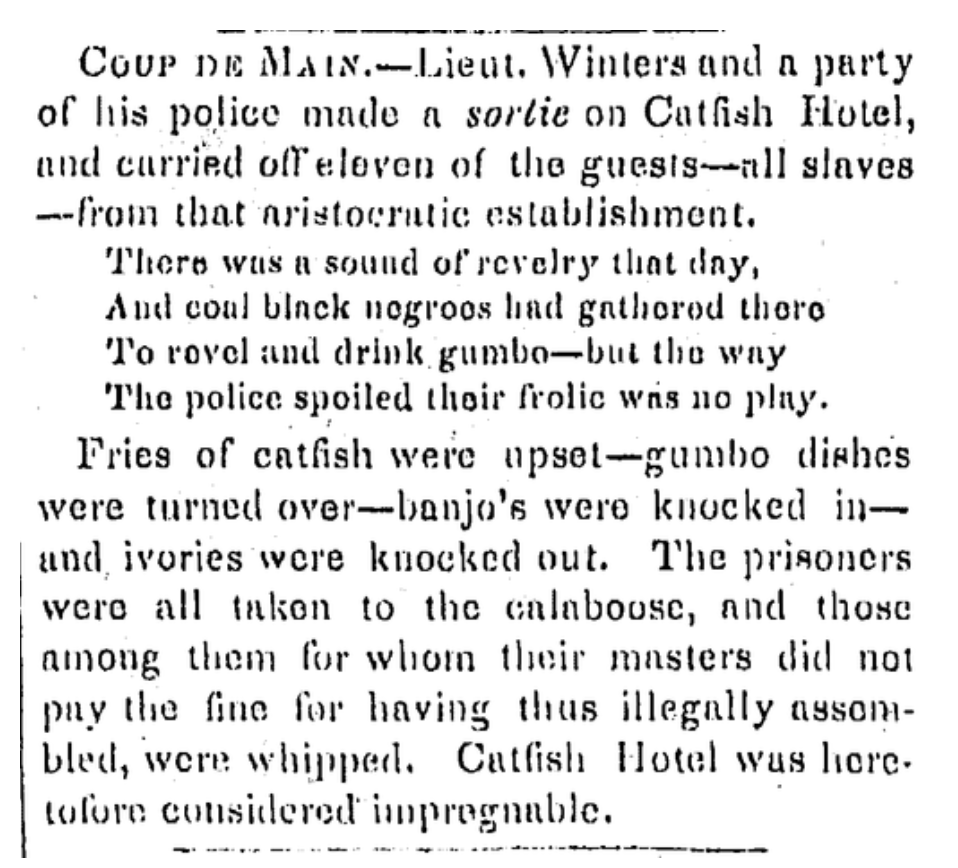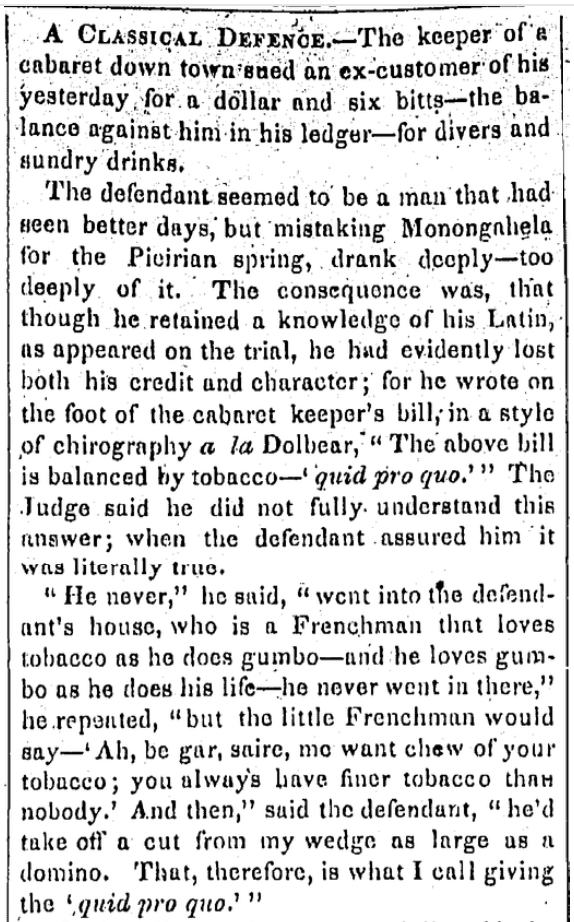Food has the ability to unify people and can have immense cultural significance. Making food from one’s culture or recreating family meals is a way to express pride in one’s ethnicity or heritage. In some cases, food can even be a mode of communication for families and communities. Some dishes may reflect generations of cultural influence and be important to the identity of a country, ethnic group, or even a city. In New Orleans, one dish that is inextricably tied to the cultural background of the city is gumbo. Gumbo, which is the state cuisine of Louisiana, is typically made from seasoned and flavorful stock, meat, a thickener, celery, and bell peppers. The dish comes from a mixture of cultural influences, including Western European, Native American, and West African. However, in the 1840s in New Orleans, the appropriation of African cuisine by the white population was in full swing. By 1841, white New Orleanians, including those arriving from the other parts of the Southern United States and those from European countries, had claimed gumbo as their own. The 1841 New Orleans Times-Picayune highlights the appropriation of gumbo by white people, which many believe represents the suppression of Black culture. In turn, this type of appropriation serves to reinforce the power structures that benefited white slave owners.
In publications from 1841, it was not unusual to see ads for okra. However, okra, which is now seen as a staple of southern cuisine, has a dark and ominous history. The word “gumbo” is thought to have originated from the phrase “ki ngombo,” which translates to “okra” in the Central Bantu dialect of West Africa, where over two-thirds of all Africans enslaved in Louisiana originated from. Okra was one of the few crops that slaves could bring with them from Western Africa. The seeds were often braided into children’s hair so they would have an inheritance when they reached the United States. When they arrived in the South, enslaved workers began to make dishes from the okra. These dishes were influenced by cooking traditions from their homelands in Western Africa as well as practices that existed locally in Louisiana. The primary cultural groups in Louisiana at the time were French colonists and Native Americans. Moreover, various ethnic influences culminated in what we now know as gumbo. However, it was slaves who first made gumbo, using okra as the main thickening agent. Okra was also a linchpin in enslaved workers’ personal gardens, providing them with food when slaveholders limited their rations.

Okra Advertisement (Times-Picayune, 1841)
Since newspapers at the time were written by and for the white communities only, the advertisements for okra in newspapers were arguably an example of the appropriation of African cooking that was occurring in the 1840s. The advertisements for okra demonstrated not only the appropriation of African culture but also the ways in which appropriation worked to keep white people in power. Okra was a unifying identity marker for Black people in New Orleans at the time and was one of the most tangible ways they could connect to their cultural roots in West Africa. By integrating okra into the white culture of New Orleans and advertising it as such, white farmers and slave owners intentionally stripped its historical and racial significance away.

Catfish Hotel Sortie (Times-Picayune, 1841)
Explicit mentions of gumbo from the Times-Picayune in 1841 reveal more about how the appropriation of the dish worked to benefit slave owners. The one mention of gumbo in a neutral or even somewhat positive context has a direct tie to white New Orleanians. The mention occurred in an issue that discussed a man who was sued by a cabaret owner. The defendant is described as a “Frenchman” who “retained a knowledge of Latin.” The man drank “too deeply” one night and tried to settle his bill at the cabaret with tobacco. Moreover, he possesses the qualities of a stereotypical New Orleanian man at the time – he is both white and “he loves his gumbo as he does his life.” By painting the man as the epitome of New Orleans and connecting his white French identity to his love of gumbo, gumbo being depicted as a white New Orleans cuisine and its African roots are ignored. Though both French and Native American cooking traditions contributed to making gumbo what it is, minimizing the role of African practices in gumbo’s creation is problematic. Popularizing gumbo as a food belonging to New Orleans culture as a whole and not recognizing the African influence promoted the idea that could not contribute to society. This false ideology also served to dehumanize enslaved Africans and keep white slave owners in power.

“A Classical Defense” (Times-Picayune, 1841)
The only mention of gumbo and Black New Orleanians in the 1841 Times-Picayune article is in a story about a disturbance that occurred at the Catfish Hotel. The article describes how police violently interrupted eleven slaves who had gathered to “revel and drink gumbo” at the hotel. These were actions so disturbing to the police that “gumbo dishes were turned over,” “banjos were knocked in,” “ivories were knocked out,” and the participants were “carried off” and returned to their slave owners. If the slave owners did not pay the imposed fine, then the slaves who gathered at the hotel would be whipped. Such violence was used as a tool to keep enslaved Africans from participating in and celebrating their culture. Nevertheless, publishing a story about a Black food for white readers further emphasized that gumbo did not belong to the Black population.
The appropriation of Black cuisine was not the only way white people attempted to prevent the Black community from participating in their culture in the 1840s. Only six years prior, in 1835, the customary Sunday afternoon gathering of enslaved people to sing and dance in Congo Square was banned. Just as music has the power to unify a community, so do other cultural practices like cooking and eating. Food has the power to bring people together. Rituals around eating hold a special place in nearly every society, because food shapes people’s personal identities and forms and preserves cultural identities. Cooking practices have often been passed down from generation to generation. However, food has also historically been ridden with status symbolism and manipulated to emphasize differences in social standing. Banning the gatherings at Congo Square may have been a more overt way to assert control over the Black community, but attempting to undermine or destroy the cultural significance of gumbo for the growing Black population in New Orleans was another way that white people established dominance as fear about abolitionists and revolution rose.
This piece was edited by Eliza Griggs as part of Professor Kelley Crawford’s Digital Civic Engagement course at Tulane University.
 NOLAbeings
Multimedia artist Claire Bangser created NOLAbeings as a portrait-based story project that marries...
NOLAbeings
Multimedia artist Claire Bangser created NOLAbeings as a portrait-based story project that marries...
 Data corner: Adobe Suite (create a PDF, social media graphic, presentation, edit a photo and video
Data corner is where you go to work with analytics and top tech skills. It takes on everything from PERL and SQL to Canva and Sprout Social.
Data corner: Adobe Suite (create a PDF, social media graphic, presentation, edit a photo and video
Data corner is where you go to work with analytics and top tech skills. It takes on everything from PERL and SQL to Canva and Sprout Social.

The article points out the cultural appropriation of gumbo in New Orleans, highlighting its forgotten African origins.
retro bowl college